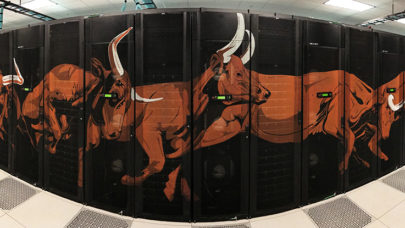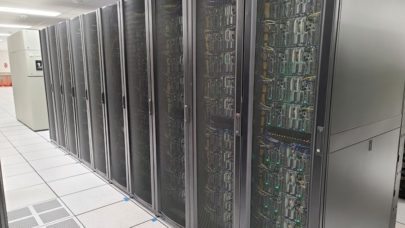
TACC Releases New Virtual Tour of the Datacenter That Hosts Stampede2, Frontera
February 4, 2021
Nearly seven years ago, the Texas Advanced Computing Center (TACC) released a then-cutting-edge YouTube virtual tour of its Stampede supercomputer. At the time, Stampede was the seventh most powerful publicly ranked supercomputer in the world, delivering 5.2 Linpack petaflops. Since 2014, of course, the standards for... Read more…

Legacy HPC System Seeds Supercomputing Excellence at UT Dallas
September 16, 2020
What happens to supercomputers after their productive life at an academic research center ends? The question often arises when people hear that the average age of a top supercomputer at retirement is about five years. Rest assured — systems aren’t simply scrapped. Instead, they’re donated to organizations and institutions that can make... Read more…

Stampede1 Reborn as BigTex, a Supercomputer for the Federal Reserve
June 18, 2020
Alex Richter, a research economist from the Federal Reserve Bank of Dallas, seeks to unravel the non-linear impacts of the business cycle and monetary policy. His research requires advanced computing to solve complicated mathematical and statistical problems. For several years, he used the modest-sized high performance computing cluster operated by the Federal Reserve Bank of Kansas City, the Ganymede cluster at the University of Texas... Read more…

TACC Helps ROSIE Bioscience Gateway Expand its Impact
April 26, 2017
Biomolecule structure prediction has long been challenging not least because the relevant software and workflows often require high-end HPC systems that many bi Read more…

TACC Director Lays Out Details of 2nd-Gen Stampede System
June 2, 2016
With a $30 million award from the National Science Foundation announced today, the Texas Advanced Computing Center (TACC) at The University of Texas at Austin (UT Austin) will stand up a second-generation Stampede system based on Dell PowerEdge servers equipped with Intel "Knights Landing" processors, next-generation Xeon chips and future 3D XPoint memory. Read more…

Weekly Twitter Roundup
April 28, 2016
Here at HPCwire, we aim to keep the HPC community apprised of the most relevant and interesting news items that get tweeted throughout the week. The twee Read more…

XSEDE Resources Fuel Investigation of Model Human Origins
August 20, 2015
A mix of data- and computation-intensive XSEDE resources are enabling researchers to scale up their climate, vegetation and agent-based human behavior models to Read more…

Better Taxation Through Supercomputing
October 15, 2014
Should the US raise taxes on the top 1 percent of earners? One of the country's top supercomputers has been tasked with answering this question. Early findings Read more…

- Click Here for More Headlines

Whitepaper
Transforming Industrial and Automotive Manufacturing
In this era, expansion in digital infrastructure capacity is inevitable. Parallel to this, climate change consciousness is also rising, making sustainability a mandatory part of the organization’s functioning. As computing workloads such as AI and HPC continue to surge, so does the energy consumption, posing environmental woes. IT departments within organizations have a crucial role in combating this challenge. They can significantly drive sustainable practices by influencing newer technologies and process adoption that aid in mitigating the effects of climate change.
While buying more sustainable IT solutions is an option, partnering with IT solutions providers, such and Lenovo and Intel, who are committed to sustainability and aiding customers in executing sustainability strategies is likely to be more impactful.
Learn how Lenovo and Intel, through their partnership, are strongly positioned to address this need with their innovations driving energy efficiency and environmental stewardship.
Download Now
Sponsored by Lenovo
Whitepaper
How Direct Liquid Cooling Improves Data Center Energy Efficiency
Data centers are experiencing increasing power consumption, space constraints and cooling demands due to the unprecedented computing power required by today’s chips and servers. HVAC cooling systems consume approximately 40% of a data center’s electricity. These systems traditionally use air conditioning, air handling and fans to cool the data center facility and IT equipment, ultimately resulting in high energy consumption and high carbon emissions. Data centers are moving to direct liquid cooled (DLC) systems to improve cooling efficiency thus lowering their PUE, operating expenses (OPEX) and carbon footprint.
This paper describes how CoolIT Systems (CoolIT) meets the need for improved energy efficiency in data centers and includes case studies that show how CoolIT’s DLC solutions improve energy efficiency, increase rack density, lower OPEX, and enable sustainability programs. CoolIT is the global market and innovation leader in scalable DLC solutions for the world’s most demanding computing environments. CoolIT’s end-to-end solutions meet the rising demand in cooling and the rising demand for energy efficiency.
Download Now
Sponsored by CoolIT
Advanced Scale Career Development & Workforce Enhancement Center
Featured Advanced Scale Jobs:
HPCwire Resource Library
HPCwire Product Showcase
© 2024 HPCwire. All Rights Reserved. A Tabor Communications Publication
HPCwire is a registered trademark of Tabor Communications, Inc. Use of this site is governed by our Terms of Use and Privacy Policy.
Reproduction in whole or in part in any form or medium without express written permission of Tabor Communications, Inc. is prohibited.
























